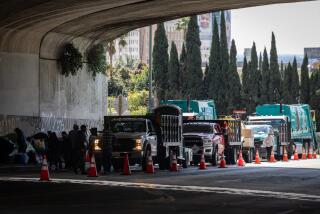Editorial: It may feel remote, but the Antelope Valley has a homeless problem too. And it needs help
The Antelope Valley — a mix of desert, poppies and suburban tract homes sprawled across the northern edge of Los Angeles County — may seem geographically disconnected from the county’s dense urban core, but it shares many of its problems. There are homeless people and there are encampments, albeit with a twist: Extremes of temperature — from triple digits on summer days to single digits on winter nights — inspire unsheltered people to dig elaborate bunkers in the ground to escape the elements.
And like every other area of the county, the number of Antelope Valley homeless people rose in the 2017 count, only more sharply than most — by an alarming 50%, from 3,038 to 4,559. That’s about 8% of the county’s total of 57,794 homeless people, or one-third the number of homeless people in the county’s urban core.
California State Sen. Scott Wilk (R-Santa Clarita), who represents the Antelope Valley, contends that his district’s homeless people have been shortchanged when it comes to federal aid. The culprit, Wilk says, is the Los Angeles Homeless Services Authority, which disburses grants from the U.S. Department of Housing and Urban Development to service providers.
The Antelope Valley needs more services providers, not simply more funding.
Documents from the homeless authority appear to bear Wilk out. They show that slightly more than $1.2 million in federal funds in the last fiscal year went to the Antelope Valley, while $47 million went to the service area that includes skid row, Hollywood, West Hollywood and mid-city, even though the latter served just four times as many homeless people as the former. Put another way, the Antelope Valley received about $400 in federal aid per homeless person; the downtown and mid-city service area collected about $4,000 per homeless person.
So is the homeless authority treating Antelope Valley unfairly — as its leaders often complain that the county of Los Angeles does in so many areas?
At Wilk’s request, the Joint Legislative Audit Committee voted to audit the Los Angeles Homeless Services Authority to see how it administers funds. That’s fine, but a look beneath the surface suggests that the disparity isn’t the work of the homeless authority. LAHSA isn’t the final arbiter of who gets the dollars HUD supplies the county ($105 million for the 2016-17 fiscal year). It is something of a gatekeeper, but it can’t send money to places that aren’t asking for it.
Service providers apply for grants from HUD through the homeless services authority, which compares them to other new and renewing applicants around the county. The ones with the best chances to win federal dollars are sent on to HUD, which makes the final decision. The competition for dollars is fierce, and HUD favors programs that combine housing and supportive services or that rapidly rehouse people who have recently lost their homes.
And, obviously, you can’t get these funds if you don’t apply. But for 10 years — from 2003 to 2013 — Antelope Valley service providers literally did not apply for any federal grants, according to LAHSA. Between 2014 and 2016, eight proposals were submitted to LAHSA and six forwarded to HUD. Four were eventually funded.
The bigger issue here is that the Antelope Valley needs more services providers, not simply more funding. On that most everyone involved, including LAHSA officials, agrees.
Some respected service providers — such as Valley Oasis, which runs several homeless programs — do operate there, but not enough. Although numerous churches have stepped up admirably to help homeless people, they don’t have the capacity to handle the rising numbers.
County officials need to confront the shortage of providers in that region. LAHSA officials say they plan to hire consultants to offer providers across the county technical assistance with grant writing as well as managing their organizations. Antelope Valley service providers should take advantage of those efforts. Meanwhile, LAHSA should should help strengthen existing providers and encourage new efforts in the region.
The availability of funds from Measure H, the sales tax increase that county voters approved in March to raise $355 million a year for homeless services, could also have a big impact on the Antelope Valley. Some of the dollars will be allocated across the county by the proportion of homeless people in each service area, although service providers will still have to apply for them.
There is funding for the services that Antelope Valley needs. Let’s work harder to get it there.
Follow the Opinion section on Twitter @latimesopinion or Facebook
More to Read
A cure for the common opinion
Get thought-provoking perspectives with our weekly newsletter.
You may occasionally receive promotional content from the Los Angeles Times.






